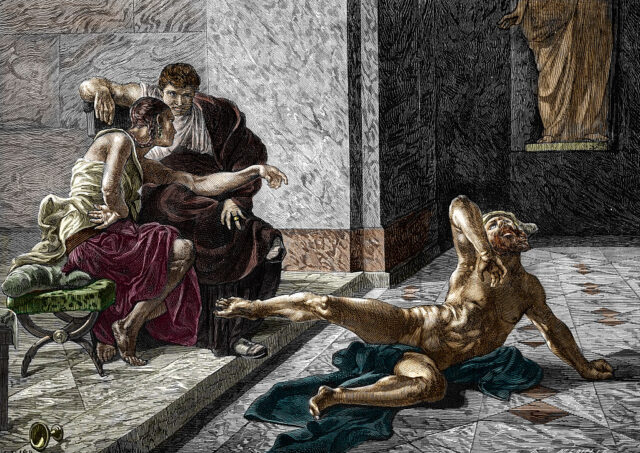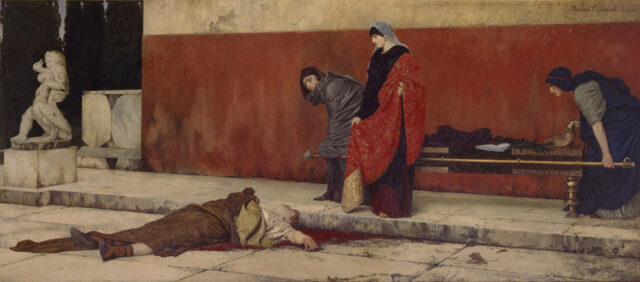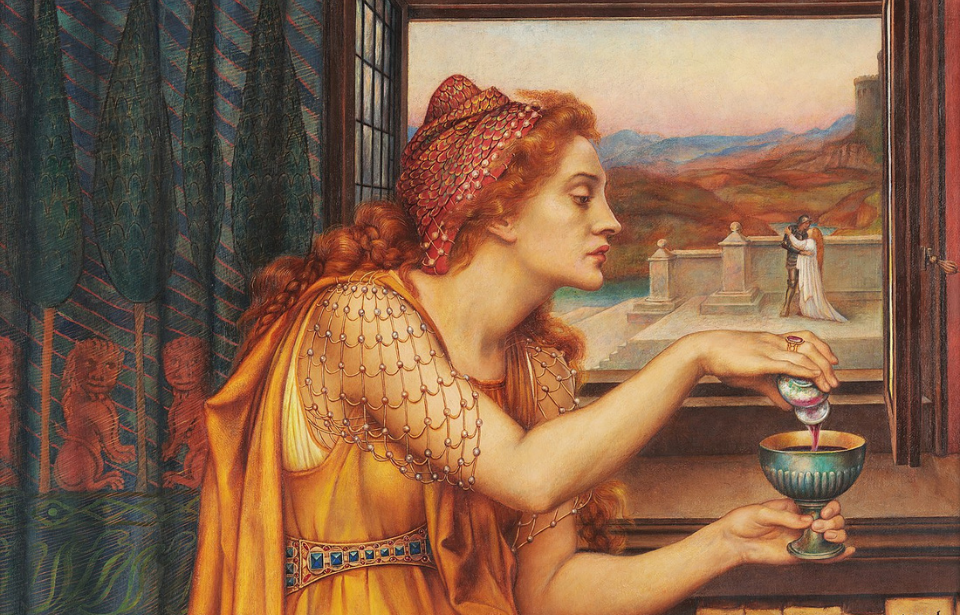Locusta of Gaul was one of the most famous poison makers of the classical world, exercising her skills within the first-century Roman Empire. She played a role in the assassinations of an emperor and his heir, and although there is very little written about her, one thing stands out: she may have been one of the world’s first serial killers.
Poisoning was common in Ancient Rome

A common way to carry out an assassination in Ancient Rome was to use poison. Poison was quiet, it didn’t require any kind of noisy conflict or confrontation, and it could effectively end someone’s life without giving away the responsible party.
With a rise in poisonings came a rise in the fear of being poisoned. As such, emperors and people of political importance hired food tasters or used slaves to ensure their food and drink were free from poison before they consumed them.
One of the most popular herbs used for creating poisons in antiquity was Atropa Belladonna, also known as “deadly nightshade.” By the first century, writers were recording the necessary doses to induce hallucinations, as well as to kill a person. Administering poisons had become a learnable craft.
The story of a woman who became extremely skilled in this practice was mentioned by several ancient historians including Tacitus, Suetonius, Cassius Dio, and Juvenal. They all described pieces of the life of Locusta, who is considered by many today to be the world’s first serial killer.
Locusta was employed by an empress

Accounts of Locusta say that she hailed from the outer Roman province of Gaul, which is known today as France. How she came to be discovered as a professional poisoner is unclear, but at some point, she was moved from her home region to Rome.
Locusta must have developed quite a notorious reputation while in Rome, as she was already imprisoned on poison charges when she became employed by a member of the Imperial Court. Emperor Claudius was on the throne, and his fourth wife (and niece), Agrippina the Younger, wanted to rid herself of him and secure the ascension of her son to power, whom she had birthed from a different marriage.
As the mother of the infamous Nero, Agrippina was one of the most prominent female figures of the time. In 54 AD, she conspired with Locusta and had her produce a poison that could be used to murder her husband. It is believed that the poison she concocted to kill Claudius was made from deadly nightshade.
How she poisoned her first emperor

There was one hurdle Agrippina and Locusta had to jump through first in order for this plan to succeed, as Claudius had a food taster in his court to make sure he wasn’t assassinated by poisoning. However, Agrippina somehow convinced his food taster, Halotus, to betray the emperor. The poison was sprinkled on his mushrooms and Halotus served the meal to Claudius.
Unfortunately for Agrippina, two factors prevented her husband from dying. The first was that Locusta’s concoction was not powerful enough to ensure a speedy death. The second was that Claudius had a habit of self-inducing vomiting after meals, which limited the time the ingested poison had to act on the body.
Claudius had his doctor, Gaius Stertinius Xenophon, stick a feather down his throat to begin the process. However, this feather was also laced with poison, and it was this that finally brought an end to Claudius’ life. Agrippina and Locusta were successful in murdering the emperor.
Locusta earned more work in the Imperial Court

The next recorded account of Locusta’s life was the following year, in 55 AD. Nero became emperor following the death of Claudius, but became wary that Claudius’ son, Britannicus, would try to usurp the throne. He sought the aid of Locusta, who was in prison for poison charges surrounding Claudius’ death.
Nero pardoned Locusta so that she could create another poisonous concoction to kill Britannicus, who was just barely a teenager. Once freed, Locusta developed another fatal medley of deadly nightshade, this time including other ingredients like arsenic and mandrake.
However, when it came time to deliver the poison, it was determined that she had made it too weak. This may have been in an attempt to keep Britannicus’ death unsuspicious. Unfortunately for her, Nero was an impatient man and Locusta was punished for her failure, flogged by Nero himself for not serving Britannicus a lethal dose. He even threatened her execution if she didn’t succeed on her next attempt.
She poisoned the rightful heir to Rome’s throne

Locusta then developed a second, much stronger poison to administer to the young Britannicus, and it was delivered very sneakily. In Ancient Rome, it was common for wine to be mixed with hot water before it was served. Such a beverage was handed to Britannicus, who had his food taster check it for poison.
When his food taster confirmed there was nothing to be worried about, Britannicus ordered for the beverage to be diluted with cold water as it was too hot for him to drink. It was this water that had been poisoned, but Britannicus drank his mulled wine without a second thought.
Britannicus was known to suffer from seizures, and Nero used his epilepsy as a cover-up for his symptoms after he had been poisoned. Ancient historian Tacitus wrote that the boy “immediately lost alike both voice and breath.” Nero ordered that no one touch him during his fit, and he ultimately succumbed to the poison.
Nero rewarded Locusta handsomely for the deed

As you can imagine, Nero was quite pleased that his plan had been successful, and he had Locusta to thank for it. In exchange for her hand in murdering Britannicus, Nero rewarded Locusta with her own estates and servants, and showered her with luxurious gifts.
Nero even had students sent to Locusta’s new properties to learn her craft. To ensure that these pupils were receiving full immersion in Locusta’s practices, and to give her the opportunity to improve her skills, Nero gave her permission to use living test subjects for her poisons.
Locusta is believed to have used her lethal brews on slaves, convicted criminals, and animals that were sent to her properties. If this is true, she is responsible for the deaths of many, many human beings, murdered in cold blood. She could truly be the world’s first serial killer.
Locusta was executed for her actions

Unfortunately for Locusta, her freedom was not to last. Nero’s tyrannic reign came to an end in 68 AD when he took his own life. He did this rather than face punishment after being declared a public enemy after thirteen years of tyrannical rule. Nero died by forcing a dagger through his neck, but it seems he had previously considered consuming one of Locusta’s poisons in the chance that he had to end his life. As it turns out, he kept a fatal brew inside a golden box for his own potential use.
Without Nero’s protection, Locusta was captured. The new emperor, Galba, ordered that she be executed for her actions and her loyalty to Nero. Ancient historian Cassius Dio described how, while shackled in chains, she was led through the city alongside “others of the scum that had come to the surface in Nero’s day.”
More from us: Meet Robert Ressler – The Man Who Coined The Term ‘Serial Killer’
Poison assassinations did not come to an end in Rome following Locusta’s death. However, many believe none of these killers were nearly as skilled in the craft as Locusta had been, which was likely a good thing.
